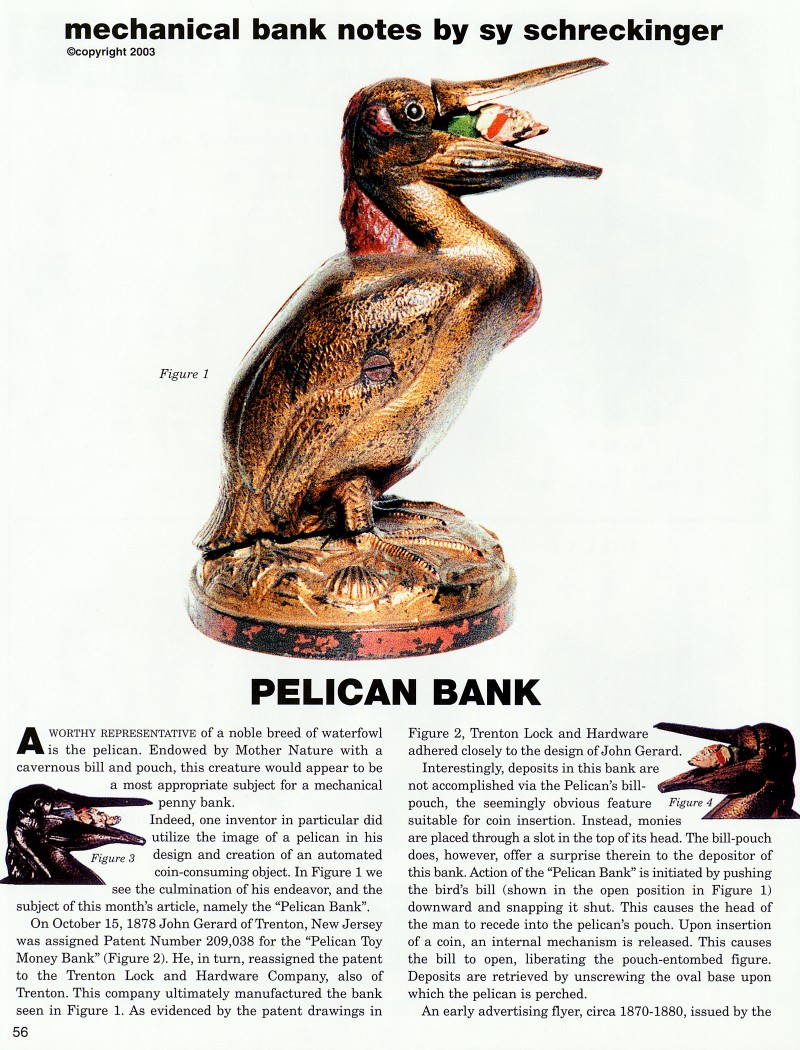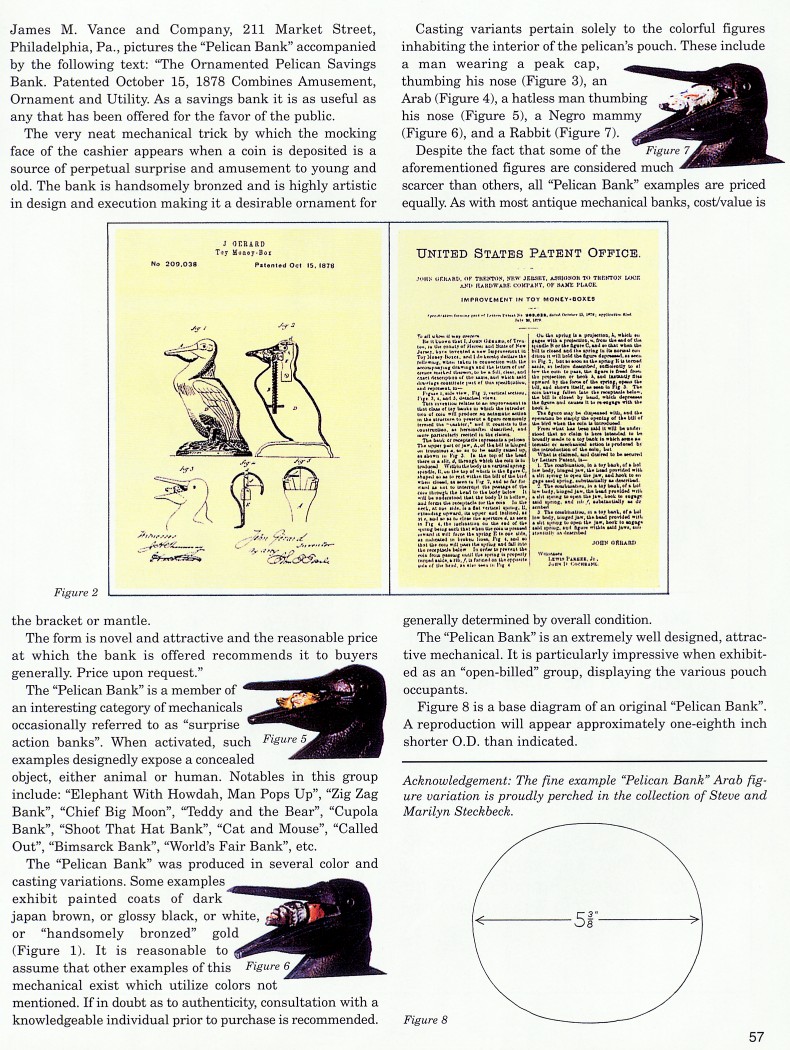|
Pelican
Bank
by Sy Schreckinger – ANTIQUE TOY WORLD Magazine – February,
2003
A worthy representative of a noble breed of
waterfowl is the pelican. Endowed by Mother Nature with a cavernous bill
and pouch, this creature would appear to be a most appropriate subject for
a mechanical penny bank.
Indeed, one inventor in particular did utilize the image of a pelican
in his design and creation of an automated coin-consuming object. In
Figure 1 we see the culmination of his endeavor, and the subject of this
month's article, namely the "Pelican Bank".
On October 15, 1878 John Gerard of Trenton, New Jersey was assigned
Patent Number
209,038 for the "Pelican Toy Money Bank" (Figure 2). He, in
turn, reassigned the patent to the Trenton Lock and Hardware Company, also
of Trenton. This company ultimately manufactured the bank seen in Figure
1. As evidenced by the patent drawings in Figure 2, Trenton Lock and
Hardware adhered closely to the design of John Gerard.
Interestingly, deposits in this bank are not accomplished via the
Pelican's bill-pouch, the seemingly obvious feature suitable for coin
insertion. Instead, monies are placed through a slot in the top of its
head. The bill-pouch does, however, offer a surprise therein to the
depositor of this bank. Action of the "Pelican Bank" is initiated by
pushing the bird's bill (shown in the open position in Figure 1) downward
and snapping it shut. This causes the head of the man to recede into the
pelican's pouch. Upon insertion of a coin, an internal mechanism is
released. This causes the bill to open, liberating the pouch-entombed
figure. Deposits are retrieved by unscrewing the oval base upon which the
pelican is perched.
An early advertising flyer, circa 1870-1880, issued by the James M.
Vance and Company, 211 Market Street, Philadelphia, Pa., pictures the
"Pelican Bank" accompanied by the following text: "The Ornamented Pelican
Savings Bank. Patented October 15, 1878 Combines Amusement, Ornament and
Utility. As a savings bank it is as useful as any that has been offered
for the favor of the public.
The very neat mechanical trick by which the mocking face of the
cashier appears when a coin is deposited is a source of perpetual surprise
and amusement to young and old. The bank is handsomely bronzed and is
highly artistic in design and execution making it a desirable ornament for
the bracket or mantle.
The form is novel and attractive and the reasonable price at which
the bank is offered recommends it generally. Price upon request."
The "Pelican Bank" is a member of an interesting category of
mechanicals occasionally referred to as "surprise action banks". When
activated, such examples designedly expose a concealed object, either
animal or human. Notables in this group include: "Elephant With Howdah,
Man Pops Up", "Zig Zag Bank", "Chief Big Moon", "Teddy and the Bear",
"Cupola Bank", "Shoot That Hat Bank", "Cat and Mouse", "Called Out", "Bimsarck
Bank", "World's Fair Bank", etc.
The "Pelican Bank" was produced in several color and casting
variations. Some examples exhibit painted coats of dark japan brown, or
glossy black, or white, or "handsomely bronzed" gold (Figure 1). It is
reasonable to assume that other examples of this mechanical exist which
utilize colors not mentioned. If in doubt as to authenticity, consultation
with a knowledgeable individual prior to purchase is recommended.
Casting variants pertain solely to the colorful figures inhabiting
the interior of the pelican's pouch. These include a man wearing a peak
cap, thumbing his nose (Figure 3), an Arab (Figure 4), a hatless man
thumbing his nose (Figure 5), a Negro mammy (Figure 6), and a Rabbit
(Figure 7).
Despite the fact that some of the aforementioned figures are
considered much scarcer than others, all "Pelican Bank" examples are
priced equally. As with most antique mechanical banks, cost/value is
generally determined by overall condition.
The "Pelican Bank" is an extremely well designed, attractive
mechanical. It is particularly impressive when exhibited as an
"open-billed" group, displaying the various pouch occupants.
Figure 8 is a base diagram of an original "Pelican Bank". A
reproduction will appear approximately one-eighth inch shorter O.D. than
indicated.
Acknowledgement: The fine example "Pelican Bank" Arab figure
variation is proudly perched in the collection of Steve and Marilyn
Steckbeck.
|


